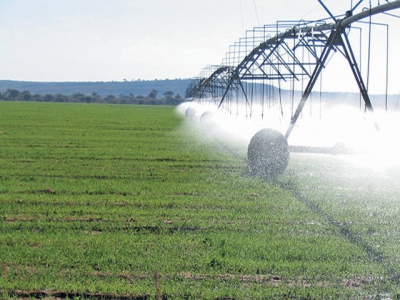Smart irrigation saves water

A degree of operational loss is unavoidable when using irrigation. But water loss because of poor or non-existent maintenance of irrigation equipment, pipelines and dams, is unacceptable.
Almost half of SA's water requirements is used for the R1,5 million hectares of land under irrigation.
Over-irrigation is another problem, says Felix Reinders of the ARC’s Institute for Agricultural Engineering. This, he adds, “is a waste of water, fertilisers and soil nutrients which are needlessly flushed beyond the root zone.”
To make up the deficit, the farmer usually applies more fertiliser, which ultimately causes algal blooms and eutrophication downstream of their lands.
Good management requires accurate measuring, diligent record-keeping, effective implementation and skilled personnel, says Reinders.
But it starts with choosing the best form of irrigation for you. There are three main types: flood, mobile and static.
Flood irrigation use gravity to allow water to flow over and infiltrate lands by means of basins or furrows. Infiltration rates can be high on certain soils. In areas with high temperatures and intense heat, flood irrigation may be preferable to sprinkler irrigation, due to the risk of leaf surfaces being burnt.
“Flood irrigation can be as efficient as drip, if correctly designed and operated,” says says agro-hydrologist Bob Lotter of Pietermaritzburg-based company Irritech.
Very accurately graded land slopes and run lengths are required in relation to particular soil type and infiltration rate, but the capital cost of establishing these slopes has become prohibitive due to the cost of diesel for land grading, he adds.
Mobile irrigation includes centre pivots, linears, and travelling guns or booms that irrigate while moving over lands. Centre pivots can operate at 90% efficiency if the design is right for the conditions and the wind speed is less than 6m/s.
However, draglines are more likely to be selected than centre pivots because of unsuitable land shape or financial constraints. ”The cost per hectare of a centre pivot decreases exponentially with area irrigated, but for dragline and fixed/static systems, the cost per hectare is relatively constant,” explains Lotter.
Historically, dragline systems have used impact sprinklers which, in comparison with pivot, micro and flood irrigation, are water-use inefficient and energy-inefficient.
Static systems are either sprinklers or sprayers such as draglines and side-roll systems, which are moved manually from one position to another at regular intervals; or permanent-set systems such as the highly efficient micro-drip, micro-spray, mini, midi and regular sprinklers which, once installed, remain in the same position indefinitely, or at least until the crop is harvested.
Micro-drip systems prevent water loss through leaf interception, and direct the water where it is needed in the root zone of the plant, says University of KZN hydrologist Prof Roland Schulze.
“Generally, irrigated crops lose 1,5mm or more through evapotranspiration per week – 1,5mm a week equals 75mm in 52 weeks.”
Drip irrigation targets the area around the plant, so there is no evaporation loss from the soil surface not covered by the crop. Irrigating at night rather than during the day is another way of overcoming the evaporation problem and has the advantage of lower night-time Eskom rates.
“The success or failure of an irrigation system depends to a large extent on careful selection, thorough planning, accurate design and effective management,” says Reinders.
Related news
 Cassava struggles to reach export goal
Cassava struggles to reach export goal Cassava is one of Việt Nam’s billion-dollar export products. But the starchy root’s dependence on a single export market as well as shrinking production supply
 Farm produce needs to improve to unlock EU market
Farm produce needs to improve to unlock EU market Việt Nam’s agricultural exports face a range of challenges and barriers in Europe due to new stringent food safety regulations.
 Exporting the livestock products: Must follow the 'command' of market
Exporting the livestock products: Must follow the 'command' of market The Vietnamese export of livestock products has prospered gradually with conquering some strict markets. In order to ensure sustainable development